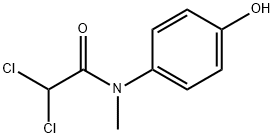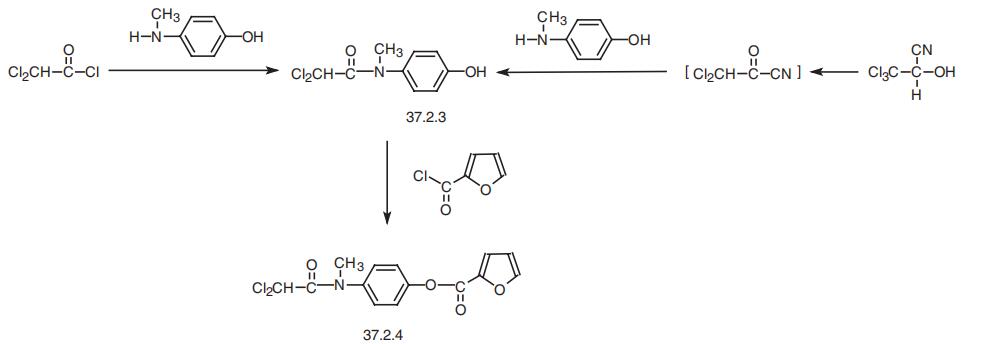- diloxanide USP/EP/BP
-

- $1.10 / 1g
-
2021-06-18
- CAS:579-38-4
- Min. Order: 1g
- Purity: 99.9%
- Supply Ability: 100 Tons Min
- diloxanide
-

- $0.00 / 1Kg
-
2020-04-28
- CAS:579-38-4
- Min. Order: 1KG
- Purity: 99.0%
- Supply Ability: 500 tons
|
| Product Name: | diloxanide | | Synonyms: | diloxanide;α,α-Dichloro-4'-hydroxy-N-methylacetanilide;2,2-dichloro-N-(4-hydroxyphenyl)-N-methylacetamide;2,2-dichloro-N-(4-hydroxyphenyl)-N-methyl-acetamide;2,2-dichloro-N-(4-hydroxyphenyl)-N-methyl-ethanamide;Acetamide, 2,2-dichloro-N-(4-hydroxyphenyl)-N-methyl-;diloxanide USP/EP/BP;Diloxanid | | CAS: | 579-38-4 | | MF: | C9H9Cl2NO2 | | MW: | 234.08 | | EINECS: | 2094394 | | Product Categories: | | | Mol File: | 579-38-4.mol |  |
| | diloxanide Chemical Properties |
| Melting point | 175° | | Boiling point | 356.2±42.0 °C(Predicted) | | density | 1.439±0.06 g/cm3(Predicted) | | storage temp. | Store at -20°C | | solubility | DMSO:33.33(Max Conc. mg/mL);142.39(Max Conc. mM) | | pka | 9.95±0.15(Predicted) |
| | diloxanide Usage And Synthesis |
| Pharmacology and mechanism of action | Diloxanide is a dichloroacetanilide derivative that was introduced in 1956. It is amoebicidal in vivo and in vitro. It is highly effective in asymptomatic patients passing cyst forms. Sufficient data are not available on its efficacy when used alone in acute amoebiasis[1]. The mechanism of action of diloxanide is unknown. Like the structurally related chloramphenicol, diloxanide has been suggested to block the protein synthesis in the microorganism [2].
| | Indications | Diloxanide is the drug of choice in the treatment of asymptomatic passers of cysts of Entamoeba histolytica in non-endemic countries. It is also given after metronidazole treatment to eradicate residual amoeba in the intestine.
| | Side effects | Diloxanide is usually well tolerated even at high doses. In one study [3], excessive flatulence was the only significant side effect recorded in 87% of the patients, but was also a common complaint among the patients (31%) even before treatment. Other minor side effects included anorexia (3%), nausea (6%), diarrhoea (2%), and abdominal cramps (2%). Flatulence as a frequent side effect of diloxanide has also been reported in a large retrospective study covering more than 4000 patients who used the drug during 1977 until 1990 in the United States[4]. Other less frequent side effects reported in the survey included headache, lethargy, dizziness, diplopia, and paraesthesia. The percentage of persons reporting adverse effects varied significantly by racial group. The existence of racial differences in the metabolism of diloxanide is unknown.
| | Contraindications and precautions | There are no known contraindications to the drug.
| | Interactions | There have been no reports. | | Preparations | Available as diloxanide furoate.
• Furamide® (Boots) Tablets 500 mg.
| | References | 1. Krogstad DJ, Spencer HC Jr, Healy GR (1978). Amoebiasis. N Engl J Med, 298, 262–265.
2. Knight R (1980). The chemotherapy of amoebiasis. J Antimicrob Chemother, 6, 557–593.
3. Wolfe MS (1973). Non-dysenteric intestinal amoebiasis: Treatment with diloxanide furoate. J Am Med Ass, 224, 1601–1604.
4. McAuley JB, Herwaldt BL, Stokes SL, Becher JA, Roberts JM, Michelson MK, Juranek DD (1992). Diloxanide furoate for treating asymptomatic Entamoeba histolytica cyst passers: 14 years’ experience in the United States. Clin Infect Dis, 15, 464–468.
| | Uses | Diloxanide is used for the treatment of amoebiasis which is an infection of the diegestive tract caused by amoebas of the entamoeba group. | | Uses | Diloxanide is also active against cysts and trophozoites localized in the lumen of the intes�tine, and it is used for treating the carrier E. histolytica, as well as for treating asympto�matic or moderate forms of amebiasis. In the transition stage to trophozoites, the drug is
less active than iodoquinol. A synonym of this drug is furamide. | | Antimicrobial activity | Diloxanide inhibits E. histolytica with unusually high specificity
at concentrations of 0.01–0.1 mg/L. | | Acquired resistance | No resistance has been reported. Patients with dysentery have
lower cure rates than cyst excreters. | | Pharmaceutical Applications | Dichloro(hydroxyphenyl)methylacetamide. Available as an
insoluble ester, the furoate, for oral administration. | | Pharmacokinetics | Human pharmacokinetic data are limited. Animal data show
that diloxanide furoate is rapidly absorbed from the intestine.
The furoate is hydrolyzed in the gut, leaving high intraluminal
concentrations of free diloxanide. About 75% is excreted via
the kidney within 48 h, mostly as a glucuronide. | | Clinical Use | Asymptomatic intestinal infection with E. histolytica
It is also used in invasive amebiasis in conjunction with
nitroimidazoles in order to eradicate luminal cysts. | | Clinical Use | Furamide, or eutamide, is the 2-furoate ester of 2,2-dichloro-4 -hydroxy-N-methylacetanilide. It was developed as a resultof the discovery that various α,α-dichloroacetamidespossessed amebicidal activity in vitro. Diloxanide itself andmany of its esters are also active, and drug metabolism studiesindicate that hydrolysis of the amide is required for theamebicidal effect. Nonpolar esters of diloxanide are morepotent than polar ones. Diloxanide furoate has been used inthe treatment of asymptomatic carriers of E. histolytica. Itseffectiveness against acute intestinal amebiasis or hepaticabscesses, however, has not been established. Diloxanidefuroate is a white crystalline powder. It is administered orallyonly as 500-mg tablets and may be obtained in the UnitedStates from the CDC in Atlanta, Georgia. | | Side effects | It is well tolerated, but flatulence is common, and nausea and
vomiting may occur. | | Synthesis | Diloxanide, 2,2-dichloro-N-(4-furoyloxyphenyl)-N-methylacetamide (37.2.4),
is made by acylating 2,2-dichloro-N-(4-hydroxyphenyl)-N-methylacetamide (37.2.3) with
-2-furoyl chloride. The 2,2-dichloro-N-(4-hydroxyphenyl)-N-methylacetiamide (37.2.3) is
made by N-acylating 4-hydroxy-N-methylaniline with either dichloroacetyl chloride, or by
an extremely original method of using chloral cyanohydrin. 
|
| | diloxanide Preparation Products And Raw materials |
|